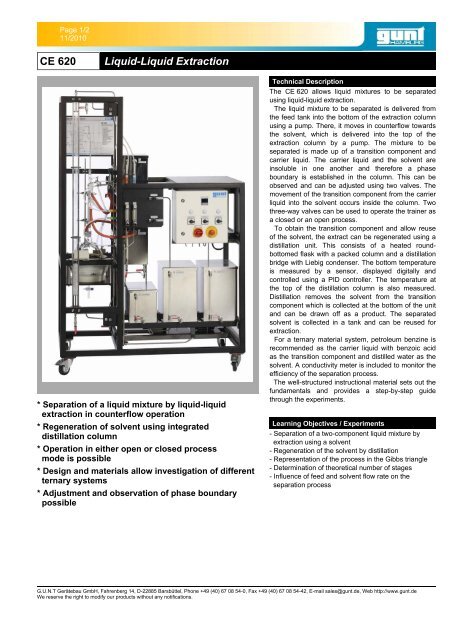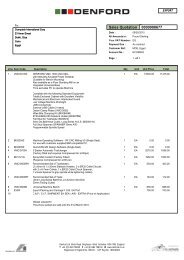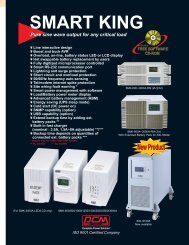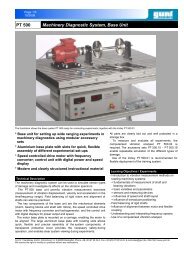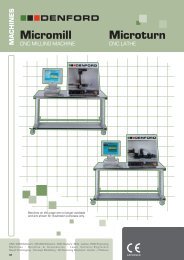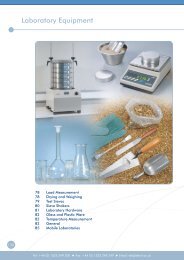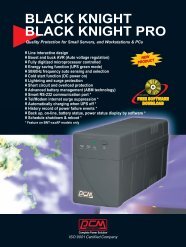CE 620 Liquid-Liquid Extraction
CE 620 Liquid-Liquid Extraction
CE 620 Liquid-Liquid Extraction
You also want an ePaper? Increase the reach of your titles
YUMPU automatically turns print PDFs into web optimized ePapers that Google loves.
Page 1/2<br />
11/2010<br />
<strong>CE</strong> <strong>620</strong><br />
<strong>Liquid</strong>-<strong>Liquid</strong> <strong>Extraction</strong><br />
* Separation of a liquid mixture by liquid-liquid<br />
extraction in counterflow operation 1<br />
* Regeneration of solvent using integrated<br />
distillation column 1<br />
* Operation in either open or closed process<br />
mode is possible 1<br />
* Design and materials allow investigation of different<br />
ternary systems 1<br />
* Adjustment and observation of phase boundary<br />
possible<br />
Technical Description<br />
The <strong>CE</strong> <strong>620</strong> allows liquid mixtures to be separated<br />
using liquid-liquid extraction.<br />
The liquid mixture to be separated is delivered from<br />
the feed tank into the bottom of the extraction column<br />
using a pump. There, it moves in counterflow towards<br />
the solvent, which is delivered into the top of the<br />
extraction column by a pump. The mixture to be<br />
separated is made up of a transition component and<br />
carrier liquid. The carrier liquid and the solvent are<br />
insoluble in one another and therefore a phase<br />
boundary is established in the column. This can be<br />
observed and can be adjusted using two valves. The<br />
movement of the transition component from the carrier<br />
liquid into the solvent occurs inside the column. Two<br />
three-way valves can be used to operate the trainer as<br />
a closed or an open process.<br />
To obtain the transition component and allow reuse<br />
of the solvent, the extract can be regenerated using a<br />
distillation unit. This consists of a heated roundbottomed<br />
flask with a packed column and a distillation<br />
bridge with Liebig condenser. The bottom temperature<br />
is measured by a sensor, displayed digitally and<br />
controlled using a PID controller. The temperature at<br />
the top of the distillation column is also measured.<br />
Distillation removes the solvent from the transition<br />
component which is collected at the bottom of the unit<br />
and can be drawn off as a product. The separated<br />
solvent is collected in a tank and can be reused for<br />
extraction.<br />
For a ternary material system, petroleum benzine is<br />
recommended as the carrier liquid with benzoic acid<br />
as the transition component and distilled water as the<br />
solvent. A conductivity meter is included to monitor the<br />
efficiency of the separation process.<br />
The well-structured instructional material sets out the<br />
fundamentals and provides a step-by-step guide<br />
through the experiments.<br />
Learning Objectives / Experiments<br />
- Separation of a two-component liquid mixture by<br />
extraction using a solvent<br />
- Regeneration of the solvent by distillation<br />
- Representation of the process in the Gibbs triangle<br />
- Determination of theoretical number of stages<br />
- Influence of feed and solvent flow rate on the<br />
separation process<br />
G.U.N.T Gerätebau GmbH, Fahrenberg 14, D-22885 Barsbüttel, Phone +49 (40) 67 08 54-0, Fax +49 (40) 67 08 54-42, E-mail sales@gunt.de, Web http://www.gunt.de<br />
We reserve the right to modify our products without any notifications.
Page 2/2<br />
11/2010<br />
<strong>CE</strong> <strong>620</strong><br />
<strong>Liquid</strong>-<strong>Liquid</strong> <strong>Extraction</strong><br />
Specification<br />
[1] <strong>Liquid</strong>-liquid extraction in counterflow operation with<br />
regeneration of solvent<br />
[2] Operation as closed or open process using<br />
2 three-way valves<br />
[3] Glass extraction column<br />
[4] Distillation column and distillation bridge with Liebig<br />
condenser for solvent regeneration<br />
[5] Electrical bottom heating via PID controller<br />
[6] Water jet pump for reduction of evaporation<br />
temperature during regeneration<br />
[7] Stainless steel tanks for feed, solvent, raffinate,<br />
extract and regenerated solvent<br />
[8] 2 pumps to deliver the feed and solvent<br />
[9] 2 valves for adjusting the phase boundary<br />
[10] Both columns packed with Raschig rings<br />
1 extraction column, 2 extract tank, 3 flow meters feed and solvent, 4 regenerated<br />
solvent tank, 5 distillation unit, 6 valve for phase boundary, 7 solvent tank, 8 feed<br />
pump, 9 solvent pump, 10 feed and raffinate tank, 11 switch cabinet, 12 three-way<br />
valves, 13 process schematic<br />
Technical Data<br />
Columns<br />
- extraction: diameter: 40mm, height: 1500mm<br />
- distillation: diameter: 30mm, height: 415mm<br />
Bottom heater power output: 1200W<br />
Tanks<br />
- feed and raffinate: approx. 30L each<br />
- solvent and extract: approx. 15L each<br />
- regenerated solvent: 15L<br />
- distillation bottom tank: approx. 5L<br />
Feed pump<br />
- max. flow rate: 1000ml/min<br />
- max. head: 80m<br />
Solvent pump<br />
- max. flow rate: 1200ml/min<br />
- max. head: 10m<br />
Water jet pump: final vacuum: approx. 200mbar<br />
Measuring ranges<br />
- temperature: 1x 0...150°C, 1x 0...120°C<br />
- flow rate: 1x 100...850ml/min, 1x 40...360ml/min<br />
- pressure: -1...0.6bar<br />
- conductivity:0...1990μS/cm<br />
Dimensions and Weight<br />
l x w x h: 1350 x 750 x 2150 mm<br />
Weight: approx. 180 kg<br />
Connections<br />
230V, 50/60Hz, 1 phase or 120V, 60Hz/CSA, 1 phase<br />
Water connection: 720L/h<br />
1 extraction column, 2 three-way valves, 3 solvent pump, 4 extract tank,<br />
5 regenerated solvent tank, 6 solvent tank, 7 water jet pump, 8 Liebig condenser with<br />
cooling water connection, 9 distillation column, 10 bottom tank, 11 feed pump,<br />
12 feed tank, 13 raffinate tank;<br />
F flow rate, P pressure, T temperature<br />
Scope of Delivery<br />
1 trainer<br />
1 conductivity meter<br />
1 set of instructional material<br />
Order Details<br />
083.<strong>620</strong>00 <strong>CE</strong> <strong>620</strong> <strong>Liquid</strong>-<strong>Liquid</strong> <strong>Extraction</strong><br />
G.U.N.T Gerätebau GmbH, Fahrenberg 14, D-22885 Barsbüttel, Phone +49 (40) 67 08 54-0, Fax +49 (40) 67 08 54-42, E-mail sales@gunt.de, Web http://www.gunt.de<br />
We reserve the right to modify our products without any notifications.


